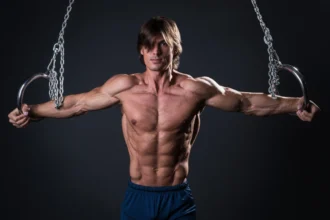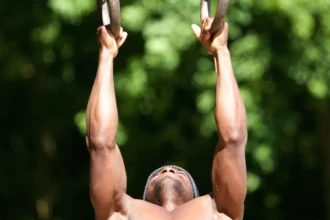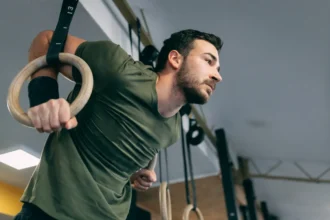The still rings, often called simply the rings, are one of the defining apparatuses in men’s artistic gymnastics. They demand immense upper-body strength, precise control, and unwavering focus. Unlike fixed equipment, the rings move freely, which means every position must be stabilized by the gymnast alone.
In this guide, we’ll walk through the classic ring positions and progressions, starting from the basic support hold and building all the way to the legendary iron cross.
1. Foundational and Basic Positions
Every gymnast begins with the fundamentals, and on rings, those basics are non-negotiable. Before advancing to iconic strength skills like the Maltese or iron cross, athletes must first learn to control the apparatus in its simplest forms. These positions may look straightforward, but they are the building blocks of stability, strength, and body awareness.
Support Hold
This is the very first position most gymnasts learn—and it’s deceptively difficult. Standing tall above the rings with arms locked straight, shoulders pressed down, and the core braced tight, the gymnast must prevent the rings from swaying. A clean support hold is the launchpad for nearly every strength move that comes later.
Handstand
Balancing in a handstand on the rings takes the familiar skill and amplifies its challenge. Instead of a stable surface, the gymnast must steady two moving handles. Holding alignment while keeping the rings under control demands rock-solid shoulders and intense focus. This position is a staple of elite routines because it combines balance with strength.
Muscle-Up
Though more of a transition than a hold, the muscle-up is considered foundational. From a hanging pull-up, the gymnast pulls high, rolls the wrists over, and presses into support. When performed smoothly, it bridges the gap between the world below the rings and the strength positions above.
Swing and Kip
Swinging is the gymnast’s first introduction to dynamic movement on rings. The goal is rhythm without losing control. From this, the kip—a sharp, controlled motion—drives the body up into support. These skills look simple but are vital for learning how to flow on the rings instead of muscling through each move.
German Hang
At first glance, the German hang resembles a deep shoulder stretch, with the body hanging upside down and the arms pulled behind. While it does stretch the shoulders, it also develops strength and resilience in extreme ranges of motion, preparing gymnasts for moves like the back lever and skin-the-cat.
Hanging Shapes: Tuck, Pike, and Straddle
Even basic body shapes matter on the rings. Practicing tucks (knees in), pikes (legs straight, hips folded), and straddles (legs wide) builds body tension and positional awareness. These shapes aren’t flashy, but they are the foundation for levers, planches, and dismount entries.
2. Strength Holds and Static Control
Once the basics are mastered, the rings become a showcase for raw, static strength. These positions are about one thing: holding perfectly still against gravity. They are the most recognizable moves on rings and the true dividing line between advanced specialists and casual athletes.
Iron Cross
The iron cross is the move everyone imagines when they think of ring strength. With arms extended out to the sides in a perfect “T,” the gymnast resists gravity with nothing but shoulder, chest, and core power. Even the smallest wobble or bend in the elbows breaks the illusion of control.
Maltese Cross & Azarian
If the iron cross is iconic, the Maltese is legendary. Here, the gymnast holds the body parallel to the ground, arms wide at ring height, as though floating in midair. The Azarian adds dynamic entry—often from a swing into a strength hold—making timing and precision critical. These are rarely seen outside elite gymnastics because of the extraordinary conditioning they demand.
Nakayama, Delchev, and Li Ning Variations
Named after world-class gymnasts, these holds and transitions push stability to the limit. The Nakayama often links cross-like positions in sequence. Delchev variations add body shifts and partial levers. Li Ning moves, inspired by the Chinese champion, showcase seamless transitions into and out of strength holds. Together, they reflect decades of technical refinement and artistry in men’s gymnastics.
3. Swing-to-Strength Combinations
Not every strength element starts from stillness. Some of the most impressive skills occur when a gymnast takes momentum from a swing and freezes into a static position. These combinations are crowd favorites and carry significant scoring value because they highlight the gymnast’s ability to control both motion and stillness.
Swing into Cross (Molinari, Honma)
In skills like the Molinari or Honma, the gymnast swings strongly forward or backward, then halts the motion at just the right instant to lock into an iron cross. The timing must be exact—too soon and the body won’t settle, too late and the swing carries through.
- Why It Matters: Blending motion into stillness demonstrates mastery of both strength and rhythm.
- Scoring Value: These skills boost difficulty scores thanks to their dynamic-to-static conversion.
- Training Focus: Gymnasts drill controlled swings, partial lowers, and assisted crosses to build consistency.
Swing-to-strength combinations give a routine fluidity, rhythm, and that unforgettable “wow” factor.
4. Dynamic Dismounts
Every routine ends with a dismount, and it’s often the defining moment of the performance. After showing stillness and strength, the gymnast explodes into the air with flips and twists, aiming to land with perfect control.
Aerial Dismounts
These are the most common dismounts and include:
- Front Tucks: Simple forward flips that emphasize clean form.
- Double Back Layouts: Two full backward rotations in layout position—a powerful and dramatic exit.
- Flyaway Variations: Tucked, piked, or laid-out flyaways, often with twists added for difficulty.
Perfect dismounts require not only explosive strength but also acute air awareness. The gymnast must release at exactly the right moment, rotate with precision, and spot the floor in time to stick the landing.
Summary Table of Classic Ring Elements
| Category | Examples |
|---|---|
| Basic / Foundation | Support hold, Handstand, Kip, German hang |
| Strength Holds | Iron Cross, Maltese, Azarian, Nakayama |
| Swing-to-Hold Transitions | Molinari (swing to inverted cross), Honma |
| Dismounts | Front tuck, Double back layout, Flyaway |
Element Groups on Rings
To ensure balance, the FIG Code of Points requires that every rings routine include elements from four distinct categories known as Element Groups (EGs):
- EG I – Kip & Swing Elements: Includes swings through or to handstand, kips, and presses. These provide rhythm and transitions.
- EG II – Strength and Hold Elements: The iconic statics like iron cross, Maltese, inverted cross, and planche.
- EG III – Swing to Strength Elements: Dynamic transitions such as Molinari or Honma, where momentum freezes into a static hold.
- EG IV – Dismounts: The final aerial skills—flyaways, tucks, doubles, and twisting layouts.
Source: thegymnasticsauthority.com
By including at least one element from each group, gymnasts meet composition requirements and avoid deductions. More importantly, this balance reflects the true nature of rings: an event where swing, strength, and flight all come together.






